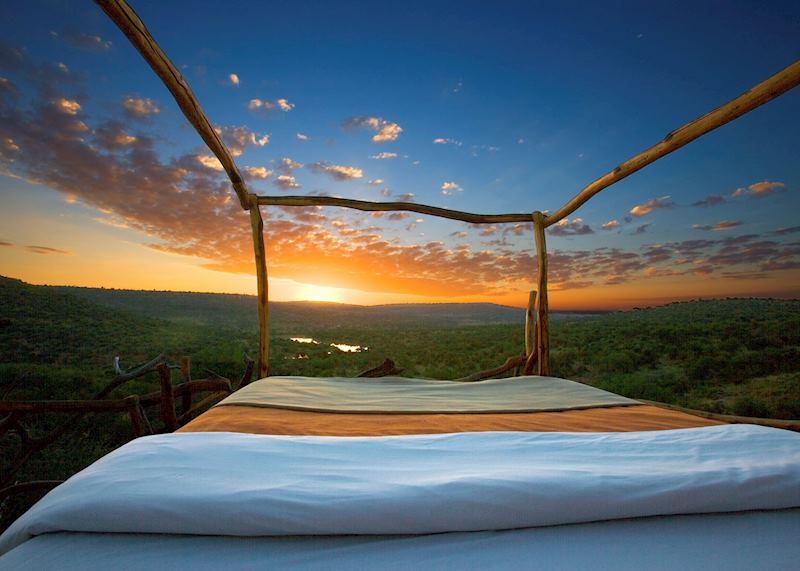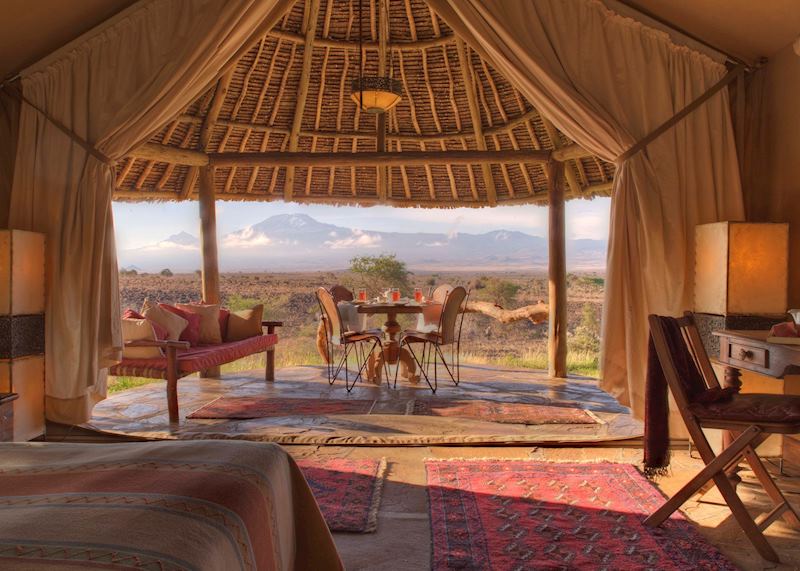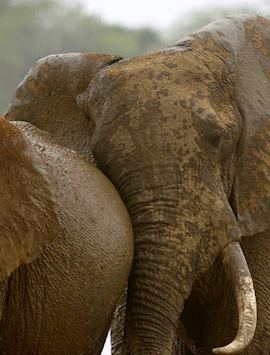By Kenya specialist Arista
Open plains scattered with wildlife, rocky kopjes, distant mountains, and sparkling lakes — Out of Africa, The Lion King, and numerous David Attenborough documentaries are indebted to Kenya’s landscapes. And, despite it being Africa’s oldest safari destination, I love that you can still find relatively untouched wildlife areas if you know where to look.
With a network of well-connected roads and airports, it’s easy to mix and match the Kenya’s varied reserves, whether you’re adamant on seeing the Big Five and the Great Migration herds in the Masai Mara or would rather focus on rarer species in Kenya’s more arid north. Wherever you choose to explore (I’ve detailed my top suggestions below), I recommend a route that includes both a safari and time on the beach, ending your trip on the white sands of Kenya’s lengthy coastline.
A classic safari in the Masai Mara

Needing little introduction, the Masai Mara National Reserve is home to all the big hitters. Lions, leopards, and cheetahs hunt herds of wildebeests and zebras, whose numbers swell during the Great Migration months of July to October. Elephant herds use their trunks to navigate to the nearest water source, and giraffes tear leaves off acacias with their long charcoal tongues.
Rhinos can be harder to spot, usually hiding in pockets of forest, but you can sometimes see them on hot-air-balloon rides at dawn. Soaring into the sky with a blast of fire, you float over the plains as the rising sun gradually illuminates the land, speckled with antelopes, wildebeests, and zebras
On my own flight, I could make out crisscrossing paths trodden into the ground by countless elephants, and then, to my luck, we flew right over a white rhino in the trees. On landing, I was treated to breakfast out in the bush, as is tradition.
Guided wildlife drives are the main activity in the Masai Mara — usually one in the morning and one in the afternoon, so you’re back at camp during the hottest part of the day.
I recommend staying in one of the Maasai-owned private conservancies bordering the main reserve. Animals have free movement, but visitor numbers are limited, so you often get wildlife sightings all to yourself.
I like the simplicity and intimacy of Kicheche Bush Camp in the Olare Motorogi Conservancy. Game drives focus on photography, and you can take guided walks through the bush.
Walking safaris & sleepouts in the Laikipia Plateau

The Laikipia Plateau not only supports large elephant herds, thriving lion prides, and the occasional leopard or cheetah, but it also provides a habitat for more endangered species than anywhere else in East Africa.
A vast tract of land, it spreads from the shores of Lake Baringo to the foothills of Mount Kenya, whose jagged silhouette forms a constant backdrop.
You might see Grévy’s zebras and Jackson’s hartebeests grazing the plains, sitatungas on the riverbanks, and wild dogs readying themselves for an evening hunt.
Rare subspecies are also attracted to this drier part of the country. You stand a chance to see reticulated giraffes, Somali ostriches, gerenuks (also known as giraffe gazelles for their long necks), and beisa oryx.
What I like about staying in this area is the variety of activities on offer alongside the usual wildlife drives. On guided bush walks, you notice a broader spectrum of wildlife, including insects, birds, and reptiles. You can also explore on horseback (if you’re an experienced rider) or by mountain bike for different vantage points.
A particular highlight, though, is sleeping out at the Loisaba Starbeds. Perched on a kopje in the Loisaba Wilderness Conservancy, with far-reaching views over the plains, the hand-crafted four-poster beds are set on platforms with nothing but mosquito nets separating you from the constellation-lit night sky.
Your stay here contributes both to the conservation of wildlife in the conservancy and to the education and welfare of local Samburu and Maasai people, who’ve grazed their cattle on the land for generations.
Rhinos & birdlife at Lake Naivasha & Lake Nakuru

Spending a few days on the shores of Lake Naivasha, in the Great Rift Valley, is a good way to slow down your safari experience.
I’d stay at Loldia House, right on the lake’s north shore. There are just nine rooms at this old colonial residence, in cottages dotted around the grounds.
You don’t need to leave the property to see the wildlife that gathers at the lake. Hippo partially submerge themselves in the water (you’ll likely also hear their snorts) and more than 400 bird species flit, hover and wade around the lake.
You can get closer to the birdlife on boat safaris led by the resident ornithologist. I photographed kingfishers and white-fronted bee-eaters perched in the papyrus, cormorants drying their outspread wings, and fish eagles keeping watch over the water.
During your stay, I’d make time to visit Lake Nakuru National Park, about two hours away. You can go on a game drive in search of black rhino, which are under protection in the park, as well as giraffe, lion, hyena and antelope.
Flamingos have historically flocked to the lake in huge numbers, but changing water conditions in recent years have seen them migrate elsewhere. If conditions are right, though, you might be lucky enough to see some dabbling on the water.
Parched landscapes & local culture in Samburu National Reserve

Located in northern Kenya, Samburu National Reserve might seem desolate at first glance, with its stark, sunbaked landscapes, but it soon reveals itself as full of life. Wildlife drives are concentrated around the Ewaso Ng’iro River, which is an important water source for wildlife — look for elephants, buffaloes, and waterbucks on the vivid green banks or in the shade of tamarind and acacia trees.
Bateleur eagles and pygmy falcons patrol the skies, while big cats and wild dogs cover the ground on the hunt for antelopes, zebras, and oryx.
You can join local Samburu guides on bush walks, which amplify the sounds — and silence — of your surroundings and zoom in on the reserve’s flora and fauna. The experience enables you to see the surroundings through the eyes of the semi-nomadic Samburu people, from their medicinal uses of plants to animal tracking and bush survival skills.
Stay in a riverside tent at Elephant Bedroom, where you can relax in your private plunge pool overlooking the water.
Safari with views of Kilimanjaro in Amboseli National Park

Open plains sprinkled with fever trees, wildlife-rich swamps and marshes, a large dry riverbed, and the cloud-shrouded peak of Mount Kilimanjaro… Amboseli National Park showcases the best of Africa’s scenery and wildlife.
The park is known for its elephants, but it has a fine supporting cast of lions, cheetahs, buffaloes, Maasai giraffes, and leopards. The familiar plains’ wildlife is interspersed with rarer species like Burchell’s zebras, Coke’s hartebeests, white-bearded wildebeests, and Thomson’s and Grant’s gazelles, which your guide will point out on wildlife drives.
I find it an excellent place for a second or third safari — once you’ve seen all of safari’s leading characters. You might spot vervet monkeys and yellow baboons in the trees, and your guide will identify birds you’ll have likely never seen before, including lily-trotters, hamerkops, and the rare Madagascar squacco heron.
I never tire of the views from Tortilis Tented Camp, which looks straight across the plains to Kilimanjaro from its elevated position on top of a kopje. Look below and you can watch zebras, elephants, and giraffes gathered around the waterhole.
Post-safari beach stay in Kenya & beyond

When your safari ends, it’s possible to catch a direct flight from Nairobi to Zanzibar, off Tanzania’s coast. But, you can spend a few days on a beach without leaving the country — Kenya’s own coastline boasts long stretches of sand as white and soft as those on any Indian Ocean island.
Short direct flights to Diani Beach depart both from Nairobi and the Masai Mara. Within a day you could go from a morning wildlife drive to an afternoon by the ocean.
Beachside properties are scattered along this part of the coast, all mingling relaxation with water-based activities such as snorkeling, diving, and boat trips.
I like Waterlovers, set right on the edge of Diani Beach. The hotel blends Mediterranean and Swahili styles, and you can stay in a private cottage with a veranda overlooking the ocean.
Best time to go on a safari in Kenya

Wildlife viewing is at its best from July to October, when the Great Migration herds pour across the plains. November to March is also a good time for seeing wildlife in Kenya without the crowds and for pairing your safari with a beach stay, thanks to the warm temperatures. It’s best to avoid April and May, when the long rains fall. For more detail, you can read our full breakdown of the best time to visit Kenya.
Read more about trips to Kenya
Start thinking about your experience. These itineraries are simply suggestions for how you could enjoy some of the same experiences as our specialists. They're just for inspiration, because your trip will be created around your particular tastes.
View All Tours in Kenya



